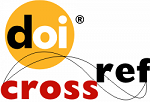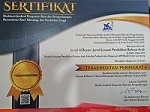Empowering Learning: Elevating Arabic Writing Skill Proficiency Through Team Assisted Individualization for Grade X Students
Abstract
Keywords
Full Text:
PDFReferences
Alharbi, Heba Awadh. “Improving Students’ English Speaking Proficiency in Saudi Public Schools.” International Journal of Instruction 8, no. 1 (2015): 105–116.
Chobanova, Hristina. “The Pedagogy of Arabic Grammar.” In Handbook for Arabic Language Teaching Professionals in the 21st Century, Volume II (2017): 344–357.
Cook, Vivian. Second Language Learning and Language Teaching. Routledge, 2016.
Fatimah, Asri Siti, Santiana Santiana, and Yuyus Saputra. “Digital Comic: An Innovation of Using Toondoo as Media Technology for Teaching English Short Story.” English Review: Journal of English Education 7, no. 2 (2019): 101–108.
Headden, Susan, and Susan McKay. “Motivation Matters: How New Research Can Help Teachers Boost Student Engagement.” Carnegie Foundation for the Advancement of Teaching (2015).
Issa, Sadam. “Comics in the English Classroom: A Guide to Teaching Comics across English Studies.” Journal of Graphic Novels and Comics 9, no. 4 (2018): 310–28.
Khan, Mehmood Ul Hassan. “Saudi Arabia’s Vision 2030.” Defence Journal 19, no. 11 (2016): 36.
Levrai, Peter, and Averil Bolster. “A Framework to Support Group Essay Writing in English for Academic Purposes: A Case Study from an English-Medium Instruction Context.” Assessment & Evaluation in Higher Education 44, no. 2 (2019): 186–202.
Lin, Ming-Hung, Huang-Cheng Chen, and Kuang-Sheng Liu. “A Study of the Effects of Digital Learning on Learning Motivation and Learning Outcome.” Eurasia Journal of Mathematics, Science and Technology Education 13, no. 7 (2017): 3553–3564.
Listyani, Lydia. “The Use of a Visual Image to Promote Narrative Writing Ability and Creativity.” Eurasian Journal of Educational Research 80 (2019): 193–223.
Nasir, Junita Shariza Mohd. “Reinforcement of Rewards as Motivation for Students in Art Learning: A Case Study at a Local University.” In International Conference of Innovation in Media and Visual Design (IMDES 2020) (2020): 237–241.
Nguyen, Tuan Dinh, Marisa Cannata, and Jason Miller. “Understanding Student Behavioral Engagement: Importance of Student Interaction with Peers and Teachers.” The Journal of Educational Research 111, no. 2 (2018): 163–174.
Ning, Huiping, and Garry Hornby. “The Impact of Cooperative Learning on Tertiary EFL Learners’ Motivation.” Educational Review 66, no. 1 (2014): 108–124.
Novak, Elena. “A Critical Review of Digital Storyline-Enhanced Learning.” Educational Technology Research and Development 63, no. 3 (2015): 431–453.
Raza, Kashif. “Adapting Teaching Strategies to Arab Student Needs in an EFL Classroom.” Journal of Ethnic and Cultural Studies 5, no. 1 (2018): 16–27.
Reiser, Brian J. “Scaffolding Complex Learning: The Mechanisms of Structuring and Problematizing Student Work.” Scaffolding (2018): 273–304.
Reynolds, Krista M, Lindsay Michelle Roberts, and Janet Hauck. “Exploring Motivation: Integrating the ARCS Model with Instruction.” Reference Services Review 45, no. 2 (2017): 149–165.
Riwanda, Agus, Syahabuddin Nor, Muhammad Ridha, and Muhammad I Islamy. “Assessing Arabic Teachers’ Assessment Methods in Evaluating Students’ Literacy.” International Conference on Madrasah Reform 2021 (ICMR 2021) (2022): 198–206.
Ryan, Richard M., and Edward L. Deci. “Intrinsic and Extrinsic Motivation from a Self-Determination Theory Perspective: Definitions, Theory, Practices, and Future Directions.” Contemporary Educational Psychology 61 (2020): 101860.
Sa’idah, Nur Laila, Sholikah Mi’rotin, and Fentin Ria Agustin. “Estafet Writing Method to Improve Arabic Writing Skills Outcomes: Experimental Study on Indonesian Middle School Students.” Al-Ta’rib: Jurnal Ilmiah Program Studi Pendidikan Bahasa Arab IAIN Palangka Raya 9, no. 2 (2021): 205–214.
Stronge, James H. Qualities of Effective Teachers. Ascd, 2018.
Tavarez DaCosta, Pedro, and Geovanny Ventura. “Effectiveness of the GT Method in EFL Monolingual Adult Classes at Private Schools Institutes in the City of Puerto Plata, DR.” Online Submission (2018).
Tinungki, Georgina Maria, Budi Nurwahyu, Agus Budi Hartono, and Powell Gian Hartono. “Team-Assisted Individualization Type of the Cooperative Learning Model for Improving Mathematical Problem Solving, Communication, and Self-Proficiency: Evidence from Operations Research Teaching.” Education Sciences 12, no. 11 (2022): 825.
DOI: http://dx.doi.org/10.24042/albayan.v16i2.23797
Refbacks
- There are currently no refbacks.
Copyright (c) 2024 Jurnal Al Bayan: Jurnal Jurusan Pendidikan Bahasa Arab
License URL: https://creativecommons.org/licenses/by-nc-sa/4.0
Editorial Office:
Jurnal Al Bayan: Jurnal Jurusan Pendidikan Bahasa Arab, Arabic Education Study Program, Faculty of Education and Teachers Training, Unversitas Islam Negeri Raden Intan Lampung
Jl. Endro Suratmin 1 Sukarame, Bandar Lampung 35131-Indonesia
e-mail: jurnalalbayan@radenintan.ac.id
http://ejournal.radenintan.ac.id/index.php/albayan/index
Jurnal Al Bayan: Jurnal Jurusan Pendidikan Bahasa Arab is licensed under a Creative Commons Attribution-ShareAlike 4.0 International License. p-ISSN 2086-9282 | e-ISSN 2549-1229









